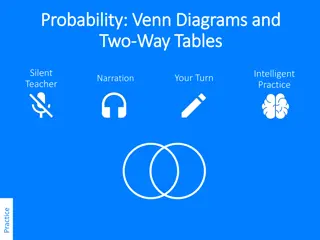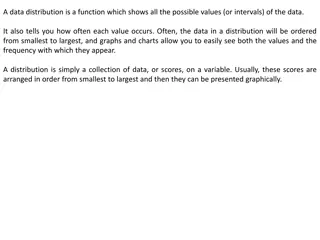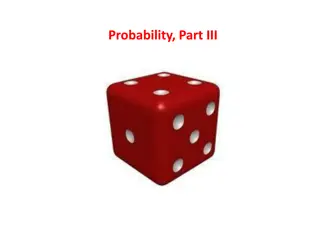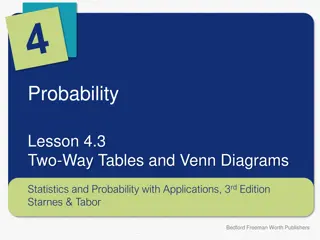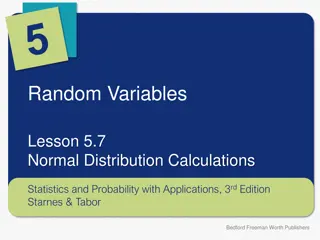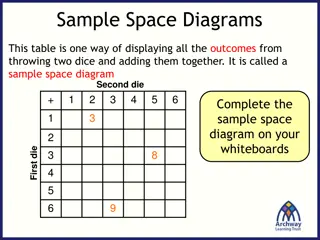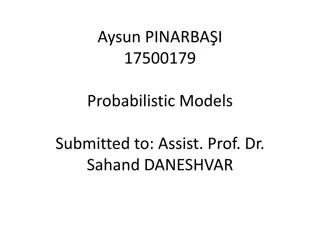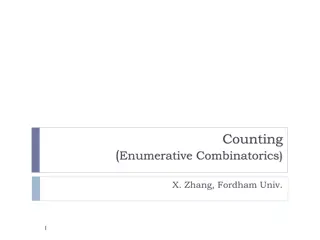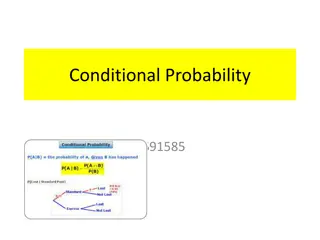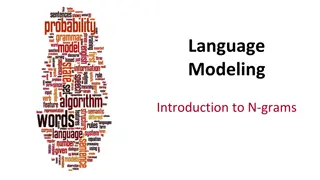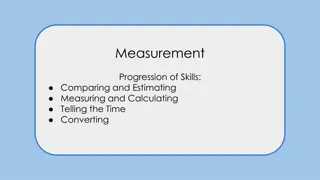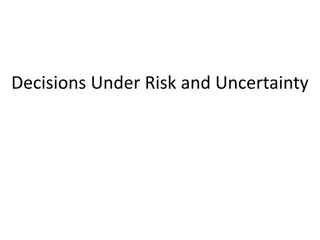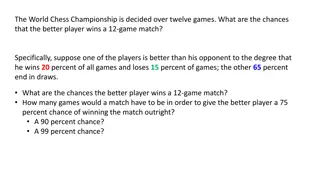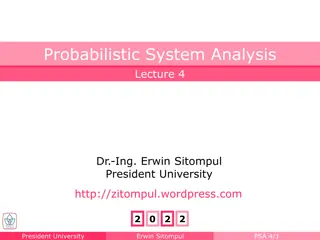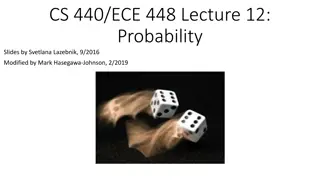Multivariate Analysis
Explore the key concepts of marginal, conditional, and joint probability in multivariate analysis, as well as the notion of independence and Bayes' Theorem. Learn how these probabilities relate to each other and the importance of handling differences in joint and marginal probabilities.
5 views • 43 slides
Understanding Conditional Probability and Bayes Theorem
Conditional probability relates the likelihood of an event to the occurrence of another event. Theorems such as the Multiplication Theorem and Bayes Theorem provide a framework to calculate probabilities based on prior information. Conditional probability is used to analyze scenarios like the relati
1 views • 5 slides
Understanding Probability Rules and Models
Probability rules and models explain how to calculate the likelihood of different outcomes in a chance process by utilizing sample spaces, probability models, events, and basic rules of probability. Learn about the importance of sample space, probability models, calculating probabilities, mutually e
0 views • 17 slides
Probability and Two-Way Tables Practice Examples
Explore various probability scenarios through Venn diagrams and two-way tables in this practice session. Calculate probabilities of students liking specific sports and subjects, and determine conditional probabilities based on given conditions. Enhance your understanding of probability concepts with
0 views • 7 slides
Understanding Data Distribution and Normal Distribution
A data distribution represents values and frequencies in ordered data. The normal distribution is bell-shaped, symmetrical, and represents probabilities in a continuous manner. It's characterized by features like a single peak, symmetry around the mean, and standard deviation. The uniform distributi
1 views • 23 slides
Understanding Probability of Simple Events
Explore the concept of probability by learning about simple events, outcomes, and calculating probabilities using favorable outcomes. Discover how to express probability as fractions, decimals, or percentages through real-world examples like coin flips and dice rolls. Enhance your understanding of c
1 views • 13 slides
Understanding Probability: Theory and Examples
Explore the concepts of probability through the classical theory introduced by Pierre-Simon Laplace in the 18th century. Learn about assigning probabilities to outcomes, the uniform distribution, and calculating probabilities of events using examples like coin flipping and biased dice rolls.
1 views • 14 slides
Understanding Probability Concepts and Calculation Methods
Learn about independent and non-independent events, multiplication rule for independent events, ways of determining probabilities theoretically and empirically, and calculating probabilities when outcomes are equally likely using examples like dice rolls. Explore the concepts of disjointness versus
0 views • 17 slides
Understanding Conditional Probability and Independence in Statistics
Conditional probability and independence are essential concepts in statistics. This lesson covers how to find and interpret conditional probabilities using two-way tables, calculate probabilities using the conditional probability formula, and determine the independence of events. Through examples li
0 views • 15 slides
Understanding Two-Way Tables and Venn Diagrams in Probability
Exploring the concepts of two-way tables and Venn diagrams in probability, this lesson delves into finding probabilities using these tools. Whether dealing with mutually exclusive or non-mutually exclusive events, the addition rule is applied to calculate probabilities accurately. Illustrated with e
0 views • 21 slides
Understanding Normal Distribution Calculations in Statistics
Exploring normal distribution calculations in Statistics involves calculating probabilities within intervals and finding values corresponding to given probabilities. This lesson delves into the application of normal distribution to determine probabilities of scoring below a certain level on tests an
1 views • 13 slides
Understanding Probabilities of Success in Clinical Trials
Exploring the concept of probabilities of success in clinical trials, this webinar discusses the assessment of new treatments, development plans, and success criteria. It covers factors like power, probability of success, and assurance in decision-making processes, emphasizing the consideration of a
0 views • 21 slides
Understanding Normal Distribution in Probability
Explore the properties and characteristics of the normal distribution, including the mode, symmetry, inflection points, and the standard normal distribution. Learn how to use standard normal tables to find probabilities and areas under the curve. Practice using examples to calculate probabilities ba
1 views • 35 slides
Exploring Sample Space Diagrams for Probability Analysis
Understand sample space diagrams through visual representations of dice games and coin toss scenarios to determine probabilities of different outcomes. Explore fair game scenarios and practice calculating probabilities based on various game rules involving dice and coins.
0 views • 8 slides
Introduction to Bayesian Classifiers in Data Mining
Bayesian classifiers are a key technique in data mining for solving classification problems using probabilistic frameworks. This involves understanding conditional probability, Bayes' theorem, and applying these concepts to make predictions based on given data. The process involves estimating poster
0 views • 20 slides
Understanding Probability and Calculating Probabilities with Z-Scores
Probability is a number between zero and one that indicates the likelihood of an event occurring due to chance factors alone. This content covers the concept of probability, the calculation of probabilities using z-scores, and practical examples related to probability in statistics. You will learn a
0 views • 12 slides
Exploring Probability Through Equally Likely Games in Remote Learning
Engage students in investigating statistical outcomes of games to enhance their understanding of probability concepts. The task involves learning and playing two games, analyzing data to make predictions and calculate probabilities. Teachers can utilize remote learning strategies, such as asynchrono
6 views • 29 slides
Understanding Probabilistic Models: Examples and Solutions
This content delves into probabilistic models, focusing on computing probabilities by conditioning, independent random variables, and Poisson distributions. Examples and solutions are provided to enhance understanding and application. It covers scenarios such as accidents in an insurance company, ge
0 views • 12 slides
Foundations of Probabilistic Models for Classification in Machine Learning
This content delves into the principles and applications of probabilistic models for binary classification problems, focusing on algorithms and machine learning concepts. It covers topics such as generative models, conditional probabilities, Gaussian distributions, and logistic functions in the cont
0 views • 32 slides
Understanding Probability: Experimental and Theoretical Concepts
Probability is the measure of the likelihood of an event happening, with experimental and theoretical probability being key concepts. Experimental probability involves determining probabilities through experience or experiments, while theoretical probability can be calculated without prior experienc
2 views • 23 slides
Understanding Probability in Functional Maths Curriculum
Explore probability concepts in functional maths, such as understanding probability scales, comparing likelihood of events, calculating probabilities of simple and combined events, and expressing probabilities as fractions, decimals, and percentages. Practice drawing probability lines, simplifying f
0 views • 8 slides
Group Decision-Making: The Wisdom of Crowds and Stupidity of Herds
This presentation by Richard Zeckhauser of Harvard University delves into the importance of rational analysis and subjective probability in group decision-making processes. It emphasizes the need to focus on collective wisdom while avoiding biases that can affect group decisions. Key concepts covere
2 views • 22 slides
Analysis of Game Players and Disk Bag Contents
Survey data on gamers' nationality and gaming platform preferences, as well as the composition of a bag of disks, are analyzed to determine probabilities of events like selecting specific disks or gamers based on nationality and platform. The analysis involves calculations of probabilities for vario
0 views • 13 slides
Counting Strategies and Examples in Enumerative Combinatorics
Understanding counting principles in enumerative combinatorics is essential for solving mathematical problems involving permutations and combinations. The concepts discussed include calculating probabilities, determining the number of outcomes, and applying counting rules to various scenarios such a
1 views • 69 slides
Understanding Conditional Probability through a Smoking Survey
Explore conditional probability through a smoking survey where probabilities of being a male who smokes, being a male in general, and smoking irrespective of gender are calculated based on provided data. The calculations help illustrate how probabilities can be derived from different scenarios withi
0 views • 80 slides
Understanding Bayes Theorem in NLP: Examples and Applications
Introduction to Bayes Theorem in Natural Language Processing (NLP) with detailed examples and applications. Explains how Bayes Theorem is used to calculate probabilities in diagnostic tests and to analyze various scenarios such as disease prediction and feature identification. Covers the concept of
0 views • 13 slides
Understanding Bikini Bottom Genetics: Predicting Traits and Probabilities
Delve into the genetics of SpongeBob's world as we explore allele combinations, phenotypes, and probabilities in predicting traits for SpongeSally, SpongeBillyBob, and other citizens of Bikini Bottom. From body shape to eye shape, uncover the genetic makeup behind Squarepants and Roundpants in this
0 views • 15 slides
Introduction to N-grams and Language Modeling
Language modeling is essential for tasks like machine translation, spell correction, speech recognition, summarization, and question-answering. Dan Jurafsky explains the goal of assigning probabilities to sentences, computing the probability of word sequences, and applying the Chain Rule to compute
0 views • 78 slides
Calculating Maximum Power Delivery to Load in Current Steering DACs
In the process of calculating the maximum power delivered to the load for current steering DACs, several steps are involved, such as determining the peak-to-peak voltage at the DAC output, converting it to RMS voltage, calculating power delivered to the load, and converting power to dBm. Examples wi
0 views • 5 slides
Tuning and Matching of 1 and 2 Loops Antenna
The aim of the project is to match the impedance of the circuit to 50 ohms at the resonance frequency of 14.8 MHz. The process involves calculating the impedance, working at low frequencies to determine key parameters, calculating capacitors, determining Q, and finally calculating tuning and matchin
0 views • 25 slides
Review of Common Algorithms and Probability in Computer Science
Exploring common quicksort implementations, algorithms with probabilities of failure, and small probabilities of failure in computer science. The content covers concepts like combinatorics, probability, continuous probability, and their applications in computer science and machine learning. Strategi
0 views • 15 slides
Measurement Progression in Skills: Comparing, Estimating, Measuring, and Calculating
Explore the progression of measurement skills from Year 1 to Year 6, covering concepts like comparing lengths, mass, time, and volume, estimating measures including money, calculating areas of shapes and volumes of objects, sequencing events in chronological order, and much more. Enhance skills in c
0 views • 6 slides
Understanding Decisions Under Risk and Uncertainty
Decisions under risk involve outcomes with known probabilities, while uncertainty arises when outcomes and probabilities are unknown. Measuring risk involves probability distributions, expected values, and variance calculations. Expected profit is determined by weighting profits with respective prob
0 views • 45 slides
Understanding Z-Scores in Data Analysis
Z-Scores are standardized measurements that indicate how far a data value is from the mean in a dataset. By calculating Z-scores, analysts can compare different data points and understand their relative positions within the distribution. This summary covers the concept of Z-scores, how to calculate
0 views • 19 slides
Probabilities in World Chess Championship Matches
The chances of a better player winning a 12-game match in the World Chess Championship can be calculated based on the probabilities of winning, losing, and drawing individual games. By expanding the expression representing the match outcomes, we find that the better player has approximately a 52% ch
1 views • 5 slides
Understanding Probabilistic System Analysis with Dr. Erwin Sitompul
Explore an in-depth discussion on probabilistic system analysis in these lectures by Dr. Erwin Sitompul from President University. Topics include random variables, probability distributions, mathematical expectation, and more. Gain insights into calculating probabilities and expected values for cont
0 views • 17 slides
Understanding Probability: Learning Outcomes and Examples
This content delves into the study of probability, covering topics such as representing probabilities of simple and compound events, calculating relative frequencies, multi-step chance experiments, theoretical and experimental probabilities. It explains concepts like chance experiments, sample space
0 views • 31 slides
Understanding Probability and Decision Making Under Uncertainty
Probability theory plays a crucial role in decision-making under uncertainty. This lecture delves into key concepts such as outcomes, events, joint probabilities, conditional independence, and utility theory. It explores how to make decisions based on probabilities and expected utility, highlighting
0 views • 34 slides
Analysis of Fakes on Trial Experiment Conducted by NSW Department of Education
The NSW Department of Education conducted an experiment called "Fakes on Trial" to explore concepts of probability and experimental outcomes. The experiment involved students predicting coin toss results, calculating probabilities, and comparing observed results with theoretical probabilities. Throu
0 views • 11 slides
Insights into Eye Color Phenotypes and Probabilities
Understanding eye color phenotypes and probabilities through visual analysis of data from Ireland, Greece, and Poland. Utilizing programming techniques to create colorized scatterplots, frequency tables, and probability lists. Observations reveal how high probabilities of certain eye colors translat
2 views • 7 slides



